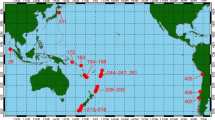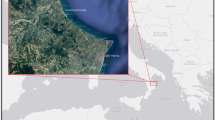Abstract
The “PTVAM” tsunami vulnerability assessment model [Papathoma and Dominey-Howes: 2003, Nat. Hazards Earth Syst. Sci. 3, 733–744; Papathoma et al.: 2003, Nat. Hazards Earth Syst. Sci. 3, 377–389], like all models, requires validation. We use the results from post-tsunami surveys in the Maldives following the December 26, 2004 Indian Ocean tsunami to ‘evaluate’ the appropriateness of the PTVAM attributes to understanding spatial and temporal vulnerability to tsunami damage and loss. We find that some of the PTVAM attributes are significantly important and others moderately important to understanding and assessing vulnerability. Some attributes require further investigation. Based upon the ground-truth data, we make several modifications to the model framework and propose a revised version of the PTVAM (PTVAM 2).
Similar content being viewed by others
References
Alexander, D.: 2000, Confronting catastrophe: new perspectives on natural disasters. Terra Publishing, 282 pp.
Chang N.-B., Wei Y. L., Tseng C. C. and Kao C.-Y. J. (1997). The design of a GIS based decision support system for chemical emergency preparedness and response in an urban environment. Comput. Environ. Urban Syst. 21(1): 67–94
Cheung K. F., Phadke A. C., Wei Y., Rojas R., Douyere Y., Martino C. D., Houston S. H., Liu P., Lynett P. J., Dodd N., Liao S. and Nakazaki E. (2003). Modelling of storm induced coastal flooding for emergency management. Ocean Eng. 30: 1353–1386
Contini S., Bellezza F., Christou M. and Kirchsteiger C. (2000). The use of geographic information systems in major accident risk assessment and management. J. Hazard. Mater. 78: 223–245
Esogbue A. (1996). Fuzzy sets modelling and optimization for disaster control systems planning. Fuzzy Sets Syst. 81: 169–183
Fischer T., Alvarez M., Dela Llera J. and Riddell R. (2002). An integrated model for earthquake risk assessment of buildings. Eng. Struct. 24: 979–998
Gambolati G., Teatini P. and Gonella M. (2002). GIS simulations of the inundation risk in the coastal lowlands of the northern Adriatic Sea. Mathem. Comput. Model. 35: 963–972
Jenkins L. (2000). Selecting scenarios for environmental disaster planning. Eur. J. Oper. Res. 121: 275–286
Papathoma, M. 2003. Assessing tsunami vulnerability using GIS with special reference to Greece. Unpublished PhD thesis, Coventry University (UK), 290 pp
Papathoma M. and Dominey-Howes D. (2003). Tsunami vulnerability assessment and its implications for coastal hazard analysis and disaster management planning, Gulf of Corinth, Greece. Nat. Hazards Earth Syst. Sci. 3(6): 733–744
Papathoma M., Dominey-Howes D., Zong Y. and Smith D. (2003). Assessing tsunami vulnerability, an example from Heraklion, Crete. Nat. Hazards Earth Syst. Sci. 3: 377–389
Pearson H. (2005). Scientists seek action to fix Asia’s ravaged ecosystems. Nature 433: 94
Peters J. and Hall G. (1999). Assessment of ambulance response performance using a geographic information system. Soc. Sci. Med. 49: 1551–1566
Pidd M. and Eglese R. W. (1996). A simulation model for emergency evacuation. Eur. J. Oper. Res. 90: 413–419
Tufekci S. (1995). An integrated emergency management decision support system for hurricane emergencies. Saf. Sci. 20: 39–48
Williams N. (2005). Tsunami insight to mangrove value. Curr. Biol. 15(3): R73
Wisner, B., Blaikie, P., Cannon, T. and Davis, I.: 2004, At risk: natural hazards, people’s vulnerability and disasters. Routledge, 2nd edn, 284 pp. http://www.asiantsunamivideos.com [accessed 11th May 2005.]
Zerger A., Smith D., Hunter G. and Jones S. (2002). Riding the storm: a comparison of uncertainty modelling techniques for storm surge risk management. Appl. Geogr. 22: 307–330
Author information
Authors and Affiliations
Corresponding author
Rights and permissions
About this article
Cite this article
Dominey-Howes, D., Papathoma, M. Validating a Tsunami Vulnerability Assessment Model (the PTVA Model) Using Field Data from the 2004 Indian Ocean Tsunami. Nat Hazards 40, 113–136 (2007). https://doi.org/10.1007/s11069-006-0007-9
Received:
Accepted:
Published:
Issue Date:
DOI: https://doi.org/10.1007/s11069-006-0007-9




